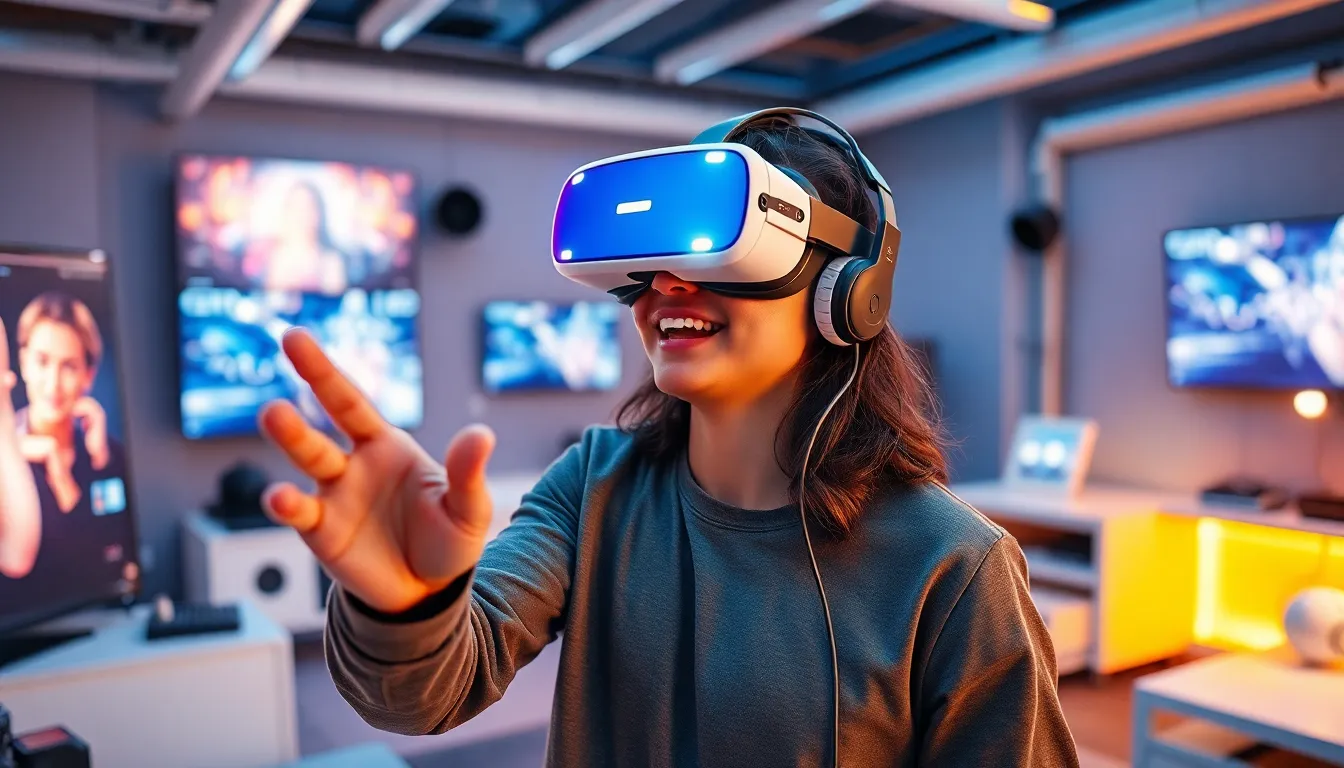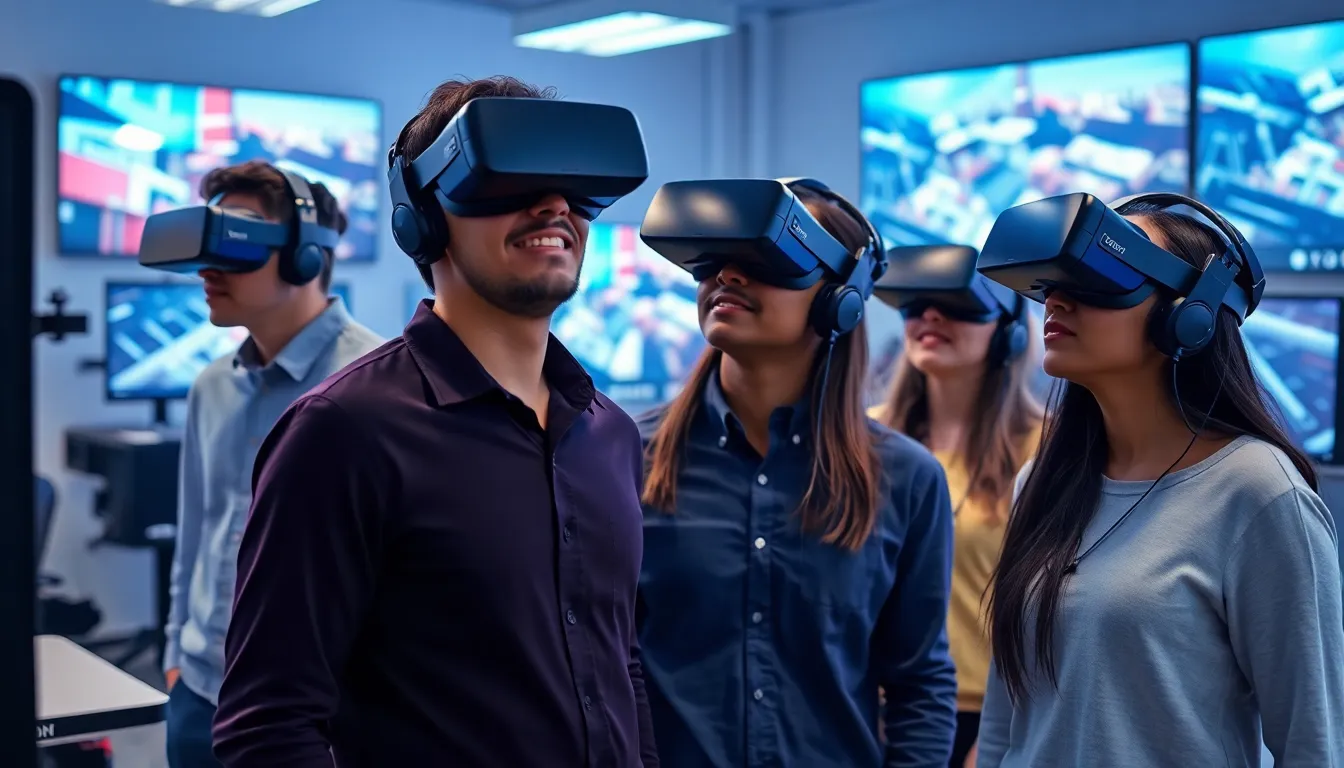Virtual reality isn’t just for sci-fi movies anymore; it’s taking the world by storm faster than you can say “where’s my headset?” From gaming to education and even therapy, VR is reshaping how we interact with technology and each other. If you thought the future was all about flying cars and robot butlers, think again—it’s all about immersive experiences that can transport you anywhere, even to a coffee shop on Mars!
Table of Contents
ToggleOverview of Virtual Reality Trends
Virtual reality is gaining momentum across various industries, with significant advancements influencing its adoption. Gaming remains a primary sector where VR enhances user engagement, providing immersive experiences that traditional gaming cannot match. Education increasingly leverages virtual reality to create interactive learning environments, allowing students to explore concepts in a more engaging manner.
Therapy stands out as another transformative area where VR is making strides. Clinicians utilize immersive environments for exposure therapy, assisting patients in overcoming phobias and anxiety disorders. Businesses are integrating VR for training simulations, improving skill acquisition and retention in fields like healthcare and manufacturing.
The rise of standalone VR headsets has contributed to broader accessibility, eliminating the need for high-end computers. Affordable options allow more users to experience virtual worlds. Companies are investing in content creation, fueling a demand for engaging applications and experiences.
Collaboration tools incorporating VR enhance remote teamwork, enabling virtual meetings where participants interact in a shared space. This trend reflects a shift toward more human-centered interactions in digital environments. Social VR platforms are emerging, focusing on creating community experiences that emulate real-life interactions.
Moreover, advancements in hardware, such as improved graphics and haptic feedback, lead to enhanced realism. The integration of artificial intelligence within VR expands possibilities, offering personalized experiences based on user behavior.
Tracking trends reveals that industries are continually embracing VR, shaping the future of how individuals engage with technology and each other.
Key Technologies Driving Virtual Reality


Several technologies drive the evolution of virtual reality, making experiences richer and more interactive. Innovations in hardware and software play critical roles in enhancing the capabilities of VR.
Hardware Innovations
Innovative hardware significantly influences VR experiences. Headsets now feature advanced displays that enhance visual quality, providing clearer images and higher refresh rates. Tracking technology has also progressed, improving motion capture and accuracy. The development of haptic devices enables users to feel textures and resistance, creating a more immersive environment. Increased affordability of standalone headsets allows broader access for users. Enhanced processing power in these devices supports more complex applications, furthering realism in varied environments.
Software Developments
Remarkable software advancements shape the VR landscape. User-friendly interfaces and intuitive controls simplify navigation, attracting more users to engage with immersive environments. Content creation software has surged, fostering the development of an array of applications catering to entertainment, education, and training. Cloud-based solutions allow for sharing and collaboration in virtual spaces, enhancing interactivity. Machine learning algorithms enable adaptive experiences personalized to user behavior, optimizing engagement. Continuous updates and support from developers ensure content remains fresh and relevant.
Industry Applications of Virtual Reality
Virtual reality technology finds numerous applications across various industries, driving innovation and enhancing user experiences.
Gaming and Entertainment
Gaming benefits tremendously from virtual reality developments. Players now immerse themselves in realistic environments, resulting in heightened engagement and interactive storytelling. Many titles incorporate VR for a fully immersive gameplay experience. With advancements in graphics and sound, developers aim to make these virtual worlds as lifelike as possible. Entertainment venues, like theme parks and arcades, also use VR to create unique attractions. Collaborative gaming experiences in shared virtual spaces foster social interaction among players, adding layers to traditional gaming formats.
Education and Training
Education increasingly employs virtual reality to create interactive learning environments. Students engage with complex subjects through immersive simulations, which can enhance understanding and retention. Many schools and institutions incorporate VR to simulate real-world scenarios, improving technical skills in various fields. Training programs utilize VR to prepare professionals for high-stakes situations, particularly in sectors such as aviation, manufacturing, and emergency response. Effective VR applications make learning more engaging by shifting focus from passive consumption of information to active participation.
Healthcare
Healthcare applications of virtual reality demonstrate significant promise in patient treatment and medical training. Clinicians use VR to conduct exposure therapy, allowing patients to confront fears in a controlled environment. Additionally, medical professionals train with simulations that replicate surgeries and complex procedures. Such training methods help develop skills without risk to actual patients. Beyond treatment, VR enhances patient education by illustrating complex medical concepts, improving understanding of conditions and treatments. Healthcare systems increasingly recognize VR’s potential to transform traditional practices, making it an essential tool in modern medicine.
Future Prospects of Virtual Reality Trends
Virtual reality continues to evolve rapidly, and its future promises exciting developments across various sectors. Innovations lead the way as industries explore new possibilities.
Emerging Markets
Emerging markets for virtual reality include training simulations, healthcare applications, and real estate. Training simulators now use VR to enhance learning experiences for professionals in fields like aviation and engineering. Healthcare employs VR for patient treatment, offering immersive environments that foster healing. Real estate is leveraging VR to create virtual tours of properties, allowing clients to explore listings from anywhere. In education, institutions are incorporating VR to create interactive classrooms that engage students in new ways. The growth of these sectors signals increased demand for VR applications, prompting businesses to invest in content creation.
Potential Challenges
Challenges in virtual reality must also be addressed as technology expands. High costs associated with advanced VR hardware remain a barrier for broader adoption among consumers. Additionally, content creation often requires significant time and resources, limiting available options. User discomfort during extended VR sessions can hinder the usability of experiences, particularly for sensitive users. Moreover, data privacy concerns arise as more interactions take place within virtual environments. Navigating these challenges will be crucial for maximizing the potential of VR and ensuring its sustainable growth across industries.
The landscape of virtual reality continues to evolve at a remarkable pace. As industries embrace this technology the potential for immersive experiences grows exponentially. From enhancing education to revolutionizing therapy VR is not just a trend but a fundamental shift in how people interact with digital environments.
With advancements in hardware and software making VR more accessible the future looks promising. Companies are investing in innovative applications while users are enjoying richer experiences. As challenges are addressed VR’s impact will likely expand into new markets creating opportunities for engagement and collaboration. The journey of virtual reality is just beginning and its influence will undoubtedly shape the way individuals connect with technology and each other for years to come.




